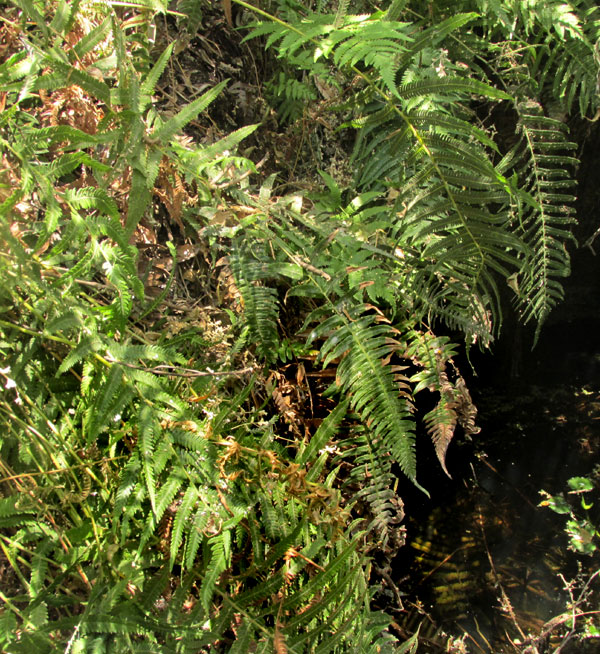Excerpts from Jim Conrad's
Naturalist Newsletter
entry dated May 21, 2022, notes from a camping trip among hills about 7kms ENE of Tequisquiapan, Querétaro state, MÉXICO
elevation about 2020m (6700 ft), near N20.57°, W99.85°
SOMETHING LIKE A MALE FERN

Here at the end of an especially dry dry-season the landscape is mostly gray and brown, except in those rare spots at the bases of cliffs and the heads of canyons where spring water seeps to the surface. In such spots a small but lush and green oasis forms, where all through the day birds and other animals come to drink, and plant species turn up not found out in the sunbaked scrub. One of those species was a fern whose fronds' lower surfaces were at the peak of exposing tiny, black, spore-producing sporangia, the sporangia emerging from beneath silvery, umbrella-like indusia, all seen above. Each roundish cluster of sporangia with its indusium is called a fruit-dot, or sorus. With such distinctive features clearly observable, one would think that identifying this fern to species level would be easy. However, it hasn't been, and in that there's a story.
The story begins with the above picture of our fern in its very moist, protected, usually shaded habitat around by a pool of water created by a small spring at the bottom of a cliff, in an otherwise extremely dry, scrubby landscape. Here's a picture of one ferny side of the tiny oasis, with cool water pooled below the ferns:

A detail of the above picture worth noticing, possibly important for solving the upcoming mystery, is shown closer up below:

Fronds of at least three kinds of fern appear in the above picture. At the top, right, that's part of the fern whose sori appear in our top picture. Notice how each long-tapering subdivision of that frond, each pinna, is deeply divided into narrow lobes almost like flattened teeth on a comb. In the image's center, the pinnae aren't as deeply cut. At the left and bottom-center, the pinnae aren't deeply cut at all. Different fern species are appearing here, all crammed densely together into a very local, isolated, fern-friendly environment.
But, back to our top picture of the sori. "Doing the botany" with the literature available on the Internet is iffy, because relatively little work has been done on Mexican ferns. It's not clear which species are to be found here. However, because fern spores can be blown great distances by wind, and here we're at elevations with a somewhat temperate environment, many fern species found here also occur in North America, where the Flora of North America authoritatively presents current insights into North American ferns. Using the Flora, our fern more or less "keys out" to the Male Fern, DRYOPTERIS FILIX-MAS, often occurring in isolated populations mostly in the western US but also the Great Lakes region, here and there in Canada, southern Greenland, and across Europe and Asia.
The trouble is, our fern's features depart in striking ways from all images I can find of the species on the Internet. Our fern is entirely too hairy, and lacks triangular scales among the hairs. The midrib of each lobe is too prominent.
However, the Flora of North America makes clear that "The taxonomy of Dryopteris filix-mas is not well understood," and that what they recognize as a species may be composed of at least two closely related taxa. Also, in the genus Dryopteris, species often hybridize. And our fern's tiny, cluttered, springside oasis is a perfect place for hybridization to take place.
Probably the best that can be done here is to file this page on the Internet with the title "aff. Dryopteris filix-mas," so that when curious folks knowing a little botany are looking for examples of the Male Fern, they'll see the "aff." in front of the name, meaning "affinity," and know that we're presenting something other than the typical Male Fern.
Beyond all that, they're called Male Ferns because there's a well-known, commonly encountered and similar looking Lady Fern, Athyrium filix-femina. Comparing the binomials and keeping in mind that in Latin filix means fern, and mas, male, it appears that even the name-givers sometimes matchmake.